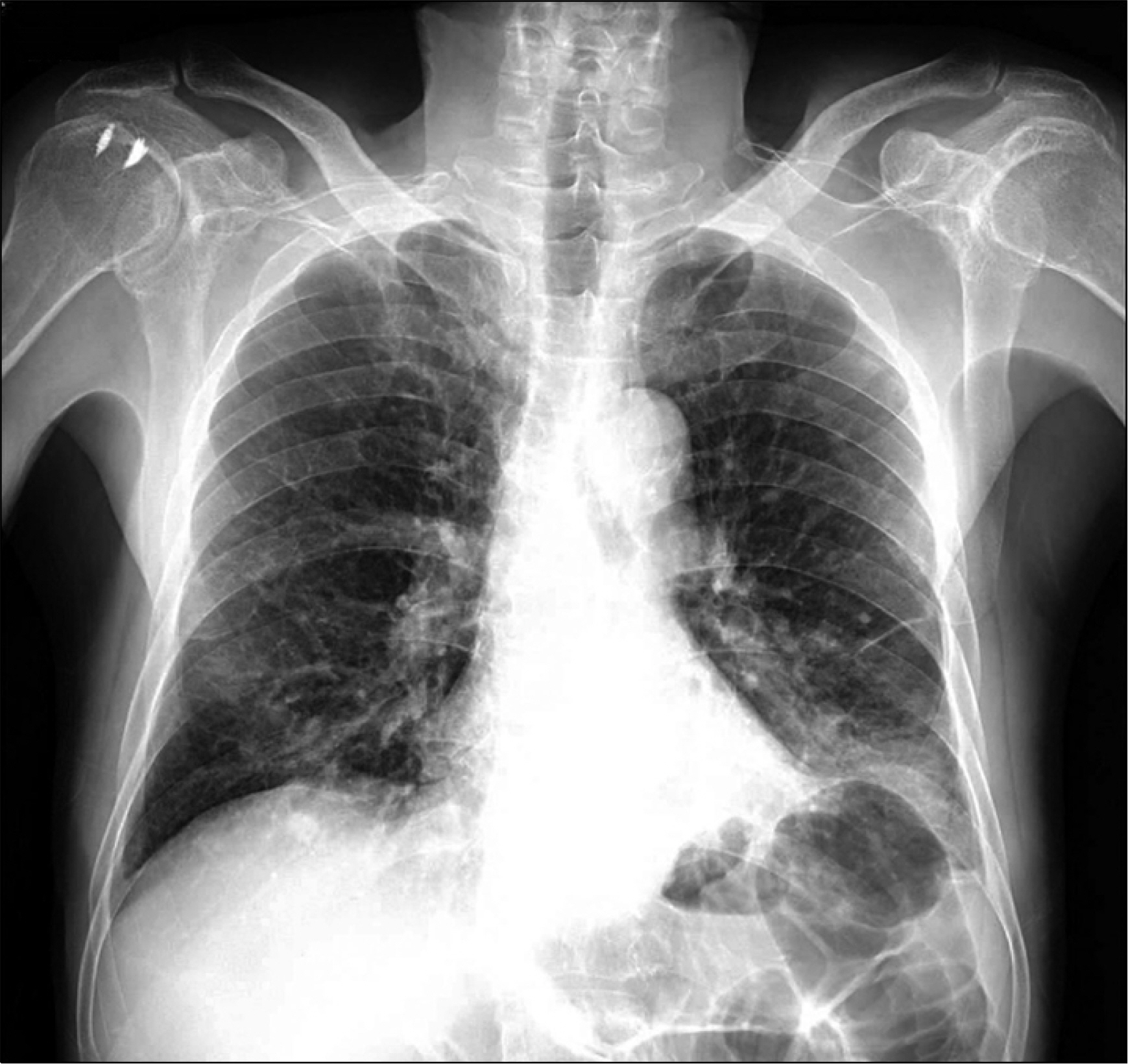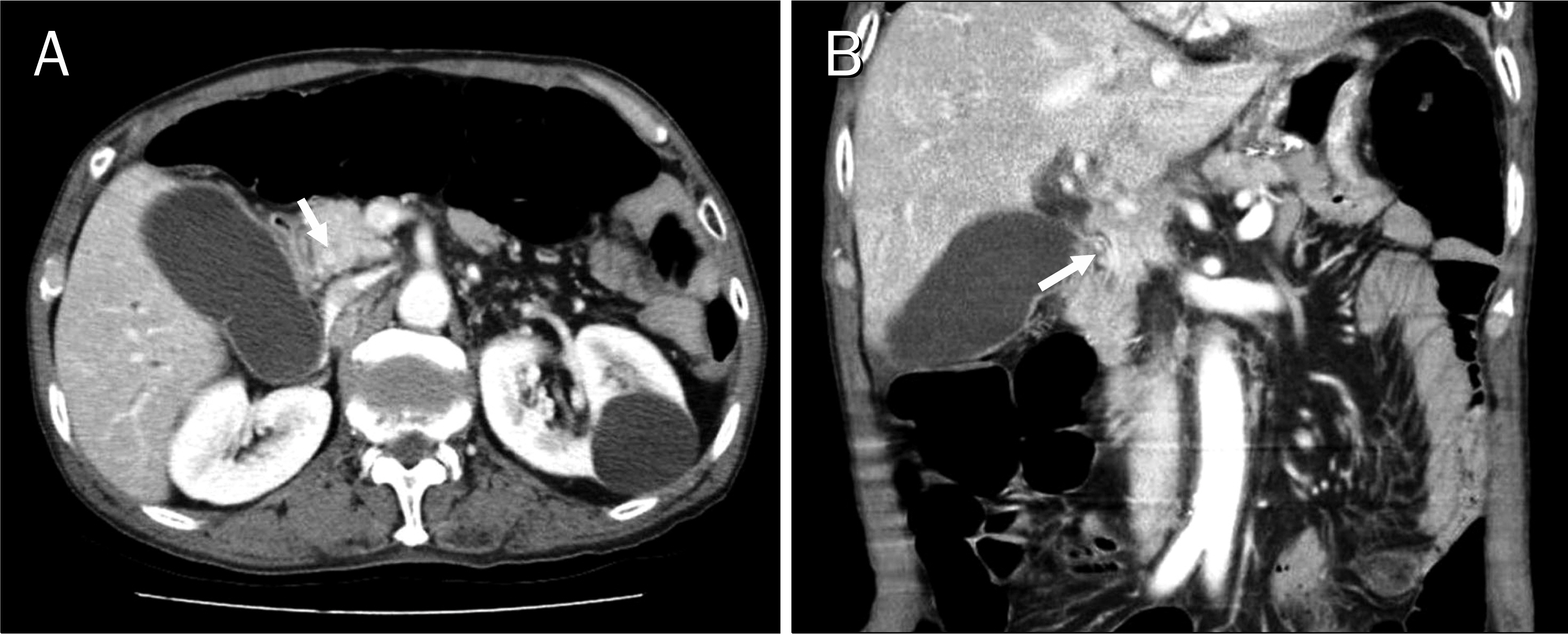Korean J Gastroenterol.
2013 Jan;61(1):50-53. 10.4166/kjg.2013.61.1.50.
Metastatic Common Bile Duct Cancer from Pulmonary Adenocarcinoma Presenting as Obstructive Jaundice
- Affiliations
-
- 1Department of Internal Medicine, Seoul Paik Hospital, Inje University College of Medicine, Seoul, Korea. nammi39@freechal.com
- 2Department of Pathology, Seoul Paik Hospital, Inje University College of Medicine, Seoul, Korea.
- KMID: 1775788
- DOI: http://doi.org/10.4166/kjg.2013.61.1.50
Abstract
- We report an extremely rare case of metastatic common bile duct cancer from pulmonary adenocarcinoma presenting as obstructive jaundice. The patient was a 76-year-old male, who presented with generalized weakness and right upper quadrant pain. Plain chest X-ray noted multiple small nodules in both lung fields. Abdominal computed tomography scan showed a stricture of the mid common bile duct along with ductal wall enhancement. Endoscopic retrograde cholangiography revealed a concentric, abrupt narrowing of the mid-common bile duct suggestive of primary bile duct cancer. However, pathology comfirmed metastatic common bile duct cancer arising from pulmonary adenocarcinoma with immunohistochemical study with thyroid transcriptional factor-1 (TTF-1).
Keyword
MeSH Terms
-
Adenocarcinoma/*diagnosis/pathology/radiography
Aged
Brain Neoplasms/radiography/secondary
Bronchoscopy
Cholangiopancreatography, Endoscopic Retrograde
Common Bile Duct Neoplasms/*diagnosis/secondary
DNA-Binding Proteins/metabolism
Humans
Immunohistochemistry
Jaundice, Obstructive/*etiology
Lung Neoplasms/*diagnosis/pathology/radiography
Male
Positron-Emission Tomography
Tomography, X-Ray Computed
DNA-Binding Proteins
Figure
Reference
-
References
1. Smith HJ. Extrahepatic bile duct obstruction in primary carcinoma of the lung: incidence, diagnosis, and nonoperative treatment. J Natl Med Assoc. 1980; 72:215–220.2. Moon SG, Han JK, Kim TK, Kim AY, Kim TJ, Choi BI. Biliary obstruction in metastatic disease: thin-section helical CT findings. Abdom Imaging. 2003; 28:45–52.
Article3. Lee YJ, Kim SH, Lee JY, et al. Differential CT features of intraductal biliary metastasis and double primary intraductal polypoid cholangiocarcinoma in patients with a history of extra-biliary malignancy. AJR Am J Roentgenol. 2009; 193:1061–1069.
Article4. Guazzi S, Price M, De Felice M, Damante G, Mattei MG, Di Lauro R. Thyroid nuclear factor 1 (TTF-1) contains a homeodomain and displays a novel DNA binding specificity. EMBO J. 1990; 9:3631–3639.
Article5. Lazzaro D, Price M, de Felice M, Di Lauro R. The transcription factor TTF-1 is expressed at the onset of thyroid and lung morpho-genesis and in restricted regions of the foetal brain. Development. 1991; 113:1093–1104.
Article6. Bohinski RJ, Huffman JA, Whitsett JA, Lattier DL. Cis-active elements controlling lung cell-specific expression of human pulmonary surfactant protein B gene. J Biol Chem. 1993; 268:11160–11166.
Article7. Fabbro D, Di Loreto C, Beltrami CA, Belfiore A, Di Lauro R, Damante G. Expression of thyroid-specific transcription factors TTF-1 and PAX-8 in human thyroid neoplasms. Cancer Res. 1994; 54:4744–4749.8. Fabbro D, Di Loreto C, Stamerra O, Beltrami CA, Lonigro R, Damante G. TTF-1 gene expression in human lung tumours. Eur J Cancer. 1996; 32A:512–517.
Article9. Folpe AL, Gown AM, Lamps LW, et al. Thyroid transcription factor-1: immunohistochemical evaluation in pulmonary neuroendocrine tumors. Mod Pathol. 1999; 12:5–8.10. Kaufmann O, Dietel M. Expression of thyroid transcription factor-1 in pulmonary and extrapulmonary small cell carcinomas and other neuroendocrine carcinomas of various primary sites. Histopathology. 2000; 36:415–420.
Article11. Dennis JL, Hvidsten TR, Wit EC, et al. Markers of adenocarcinoma characteristic of the site of origin: development of a diagnostic algorithm. Clin Cancer Res. 2005; 11:3766–3772.
Article12. Roh MS, Hong SH. Utility of thyroid transcription factor-1 and cytokeratin 20 in identifying the origin of metastatic carcinomas of cervical lymph nodes. J Korean Med Sci. 2002; 17:512–517.
Article
- Full Text Links
- Actions
-
Cited
- CITED
-
- Close
- Share
- Similar articles
-
- Metastatic mucinous adenocarcinoma of the distal common bile duct, from transverse colon cancer presenting as obstructive jaundice
- A Common Bile Duct Web Presenting with Obstructive Jaundice without Common Bile Duct Stone
- Obstructive Jaundice
- A Case of Tuberculous Lymphadenitis Causing Obstructive Jaundice
- A case of obstructive jaundice due to limy bile in the cystic and common bile ducts





